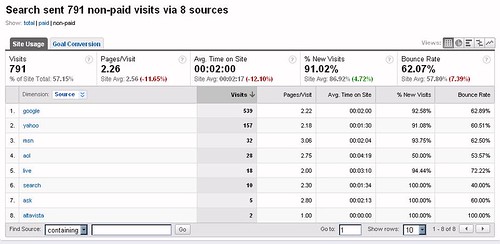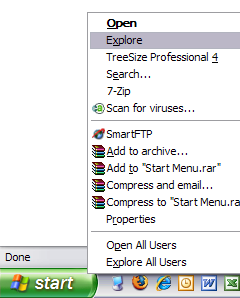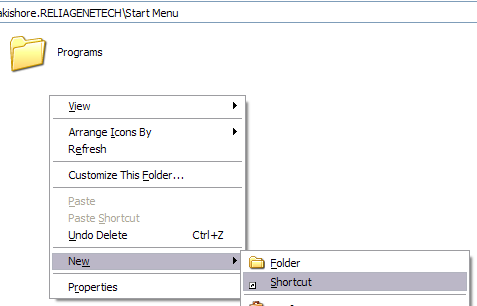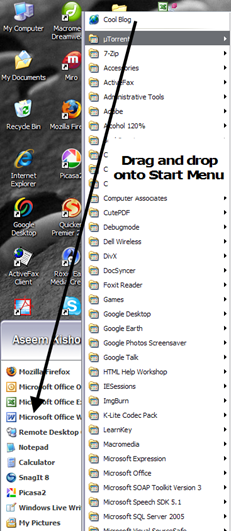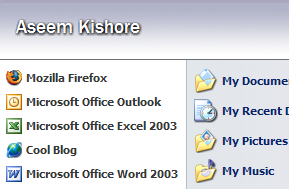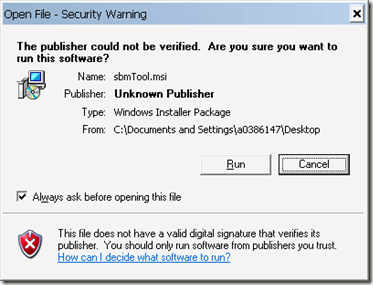A few days ago Twitter announced on their status blog that all Twitter users are only allowed to follow a maximum of 1000 people a day. This rule was designed to cut down on ‘follow spam’, the act of following many Twitter users in order to get them to follow you back or click on your links.
When combined with the already existing limit based on follow ratios, this means that it will be more difficult for marketers or self-promoters to rapidly increase their Twitter follower count by following many people. The old days of following thousands of users a day to get thousands of followers back are gone.
That’s not to say the strategy of mass following users to increase your Twitter followers doesn’t work anymore. It does. Why? Because many people use tools to auto-follow anyone who follows them. And there are new users who think its only polite to reciprocate. So you can easily get tens of thousands of followers from this strategy over time.
I see quite a few people still practicing this method. Some are social media enthusiasts or consultants, some are internet marketers or bloggers. All of them are people who want to get something in return. They want to:
- Make money. The goal is to monetize Twitter users by linking and recommending products or services, either their own or others if they are an affiliate. They do this by tweeting out links and sending automated direct messages with the same offers when someone follows them back.
- Improve their reputation. They amass followers with the aim of improving their reputation in a specific field like marketing or social media. They also use their followers to boost their prominence on other social arenas like Digg or Facebook.
- Get more visitor traffic. More followers means more visitors to their websites so they can get more subscribers, readers and members. They also want the ability to make specific content go ‘viral’ and become popular by sharing it with their followers.
Many people think that to achieve all of the above, they need to build a large list of Twitter followers and broadcast links to get free traffic. It’s a simple strategy. The more followers you have, the more people listen to you, and the easier it is to spread your messages.
But do you really need a large number of followers to promote yourself successfully on Twitter? The answer is no. Not at all. But many people still persist in mass following users. Let’s look at some of the reasons why you don’t need to use this marketing tactic.
Low-Value Followers: Automatons, Spammers and Self-Promoters
Many products on Twitter marketing have been released by internet marketers looking to profit from the growing interest in Twitter. These products give you the same blueprint: just get more twitter followers. All you need to do is to follow many users everyday, drop non-mutuals and then follow more. Repeat until you get a ton of followers and look like a social media rockstar. If people follow you, you must be awesome, right?
The only problem is that these are low-value followers. Not because they are dumb or socially inferior but because a good amount of these followers are not ultra-targeted, active or responsive. Many of them are self-promoters, spammers or automated feed accounts. These people aren’t interested in you. They don’t care about you. They didn’t REALLY opt-in. They even followed you automatically, didn’t they?
If we were to draw comparisons to a email list or newsletter, these types of people are the ones who would use a temporary email address to sign up so they can get your freebie and disappear. Most of them aren’t going to end up retweeting your stuff, most of them don’t even read your tweets. Most of them don’t give a damn about your ideas.
It’s not about the follower count, its about conversions. A carefully cultivated list of 1000 followers can beat a list of 10,000 twitter followers anytime when it comes to spreading content or getting traffic/sales. A social media strategy that only involves mass following all sorts of people and shooting out links in order to hook buyers or readers is quite inadequate.
Low-value followers are incredibly easy to get and the only positive thing about them is that they’ll make you look good. Judging influence by the follower count is something that people do. It’s social proof. So you have 80,000 followers. You can probably start a social media consulting business and tell everyone that you’re an expert. Or write that ebook and flaunt your follower count on the sales page. You can fool a lot of people and you’ll make money too.
So play the Twitter game of mass adding and dropping users for a few months. You may even meet some cool people but don’t assume that you have 50,000 users who actually read your tweets or are interested in you. They aren’t. And you’re irrelevant to them.
Remember, you’re not getting natural opt-in follows preempted by interest. All you have is an inflated number. Maybe you think that’s something to be proud of but if a 7 year old kid can press a auto-follow button and get 500 followers in 24 hrs, you’re not that impressive.
Twitter Marketing is More Than Just Getting Followers
Unless you are a celebrity or a famous brand, you will never get hundreds of thousands of natural follows from people who are interested in what you have to say. If you want to look like a VIP, you can fake it by manipulating follower counts like most self-promoters.
But do you really think that’s effective Twitter marketing? Sometimes I feel that marketers should stop this obsession with volume and carefully think about cultivating a better follower list as well as other more effective ways of using Twitter for marketing.
I don’t want to blindly label all mass-following users as spammers. Some are not malicious nor are they aggressive self-promoters. I’m just questioning the overwhelming focus on this tactic, as if its the only way to accumulate influence or market yourself on Twitter. It’s not.
This isn’t an attack on anyone. If you think that mass following many users to boost your follower count is great, keep doing it. I’ve got no problems with that. I’m just offering my opinion on why I think its flawed. This comes from having actually experimented with this strategy, so it’s not just theoretical postulations.
In my opinion, while having a large number of Twitter followers is not a bad thing, there are some other key factors you should consider if you’re want to use Twitter to market yourself or your website/brand. These are points which I think are quite important even if your ONLY reason for using Twitter is to make money or get traffic.
The most important thing you should remember: It’s not about the number of Twitter followers you have, its about who follows you and the responsiveness of your audience.
Who Follows You: The People Who Give You Their Attention

It matters who reads your tweets. Are these people interested in you or your business? An interested follower is naturally more engaged with whatever you put out on Twitter. People who automatically follow you do not count as interested followers.
Are your followers active? Active users share your links, they give you feedback, they talk to you. Automated or semi-automated users are not active users that will interact with you.
And do the people who follow you have influence? Would you rather get 50 retweets from users with 10 to 100 random followers? Or you rather get 10 retweets from influencers in same niche, with all of them having 1000 to 10,000 very relevant followers?
How about tweeting out a link or idea and having someone with a blog in the same niche write about it and link to you? Can your army of auto-followers offer the same? Not every Twitter user has the same audience size. Some users can reach more people much faster and these are the ones that can help you.
This is not to suggest that the average twitterer is useless but to highlight the unequal influence of each user. Who follows you matters a great deal because powerful Twitter marketing involves not just link-blasting but networking and relationship development.
Responsiveness of Your Audience: Are They Engaged?
Responsiveness is the degree to which your Twitter audience is engaged with whatever messages you put out on Twitter. A responsive audience connects with you, retweeting your links and answering your questions. They interact with your Twitter stream.
When we talk about a responsive email list, we’re talking about subscribers who are willing to buy or take action on your offers. Responsive Twitter followers are similar: they take action on your tweets by spreading them or talking back to you.
An easy way to measure responsiveness is to ask a question and see how many people respond. The no. of link clicks and retweets are other factors as well but anyone can click on a random link: it just shows that they’re interested in the link title or story. But are they interested in you? Actual responses to your queries are a good measure of that.
A responsive Twitter audience naturally develops when people are interested in you, what you do and who you are. Celebrities have the most responsive followers, many of their subscribers even sign up for a Twitter account just to interact with their tweets. They’re actively looking forward to reading new tweets from their favorite personality. This anticipation and interest makes them a perfect audience for conversions and call-to-actions.
If you’re not already famous, you will have a tougher time building a responsive audience because you don’t get natural interest in you from the start. One way to generate this interest is to develop a reputation in your field so that your name or brand is known.
This means you shouldn’t just spend your whole day following/unfollowing, tweeting links and chit-chatting. You have to work at your brand away from Twitter. If you put out an interesting tool or piece of content, you’ll get interest. If you’re selling a product that solves a problem, you’ll get interest. As you become more known online, you will get people following you.
When on Twitter itself, you can develop responsiveness through reciprocation. By actively interacting with other users, you will induce them to pay more attention to your updates. But don’t just send out updates and only talk to people who reply to your tweets. Actively monitor and engage users. Over time they will warm up to you and responsiveness will increase.
Remember, you don’t just want a large follower count. You want a responsive group of followers. People who are genuinely interested in you and people who will click on your links, retweet you or respond to your queries. Ultimately this group of Twitter followers can help you popularize your website or grow your business.
My Follow Strategy for Twitter Marketing
Instead of autofollowing a ton of people and rinsing them out to get mutual followers who are either not interested or very poorly interested in you, go for ultra-relevant Twitter users.
There are two types of twitter users you can target: people who have the power to help your business grow and the average user who is a potential customer. Whichever type you choose depends on your goals and what you want to get from Twitter.
Generally I’m more in favor in targeting twitter users who can best promote my business interests so you can get customers/buyers/readers through their efforts instead of your own. Potential end-users/customers are equally important although you’ll have a tougher time trying to determine their level of interest in your website/product.
Yes, you can use keywords to track tweets and find prospects on Twitter directories but interacting with each and every prospect (there are thousands out there) takes a lot of time and energy. I would prefer networking with influencers who can promote my site/brand in and outside of Twitter because they have a built-in audience and a platform.
Mass following can get you followers. But it doesn’t drastically improve your reputation, no matter how attractive a high follower count looks. A mass follower tweeting out a link is very different from an authority in the field endorsing a link by putting it in a tweet. The influencer is followed by a targeted list of other taste-makers.
The core of influence will spiral outwards based on the initial endorsement. This is more powerful than a link sent out to an auto-follow audience. Sure, you can easily get traffic but your tweets are not as effective as a voice that is respected by your target market.
So who should you network with? Not just end-users with your keyword in their bio. But bloggers, webmasters, publishers, journalists and business owners. People who work in your field and own web sites that can send you links and traffic. You can focus on networking with the superstars in your field but don’t ever forget about less famous people. This article by Brett Borders offers a good explanation of why you shouldn’t ignore the average Twitter user.
So in essence, you should use Twitter as a relationship building tool to extract benefits from a core group of influencers who are relevant to your business/website. Network actively with the right Twitter users, talk to them, spread their links, give them feedback, support their content. Be a participant in their Twitter experience.
If you do this long enough, you will eventually make them comfortable with helping you or promoting your stuff either on Twitter or away from it.
If someone talks to me very often on Twitter, shares my content or points me to good resources, I’m more than willing to retweet their stuff. Especially if its great content. I wouldn’t think twice about it. The desire to reciprocate is a very powerful instinct.
And if you want to talk about ‘going viral’, just a few retweets from several users with responsive audiences and your link will get all the momentum it needs. You don’t need to build up an account with tens of thousands of users only to send your message out to people who aren’t even half-interested in your content.
You will gradually grow your business or website by getting more readers, clients or buyers through the help of that core group. And after you’ve achieved some success, people will naturally start to follow you on Twitter. And these are the best kinds of Twitter followers to have, people who opt-in because they are interested in you or your work.
Then you can concentrate on these new batch of followers and by interacting with them, turn them into people who will actively support your content or initiatives. Many of them might be site owners or bloggers as well so this is a great way to network and learn if you’re looking for some help to improve your core business offerings.
In terms of making money indirectly or directly through Twitter, I’ve realized that the no. of Twitter followers you have is not always proportional to the income you’ll make.
It’s not necessary to inflate your Twitter follow count through an automated game of mass following. But I understand why people do it. It’s the same old strategy used on Myspace, Facebook and pretty much any social site where people can ‘friend’ each other and capture attention. The mentality is go for maximum volume and hook the few that will listen.
You can go down that route if you want but I think you can easily achieve the same results and more by cultivating a high quality list of followers and networking smartly with the right people. Marketing on Twitter does not just involve getting as many followers as you can.
Think beyond that. If you want followers, you should get them to come to you. You don’t have to chase after them. It’s devastatingly easy once you learn how to leverage other users with established audiences and create bait that entices people to opt-in because of interest.
What do you think? Feel free to leave a comment below orTalk to me on Twitter!













